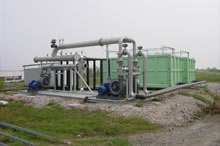Soil Remediation

In Italy, 52 large industrial areas have been classified as contaminated, for a total of 730,000 hectares, representing 2.4% of the Country and 10.4% of the plain areas (where the population is concentrated).
The contamination of these territories originated in the criminal behavior of the companies, but it is also due to the fact that such contamination is the result of long-term activities that have occurred in decades previous to environmental laws that faced the situation, requiring limits for the first time and identifying the responsibilities.
The remediation of a contaminated site is the set of procedures to heal situations ofdeep poisoning of the territory, by securing, removing and disposing of the pollutants: chemicals deliberately released or accidentally leaked into the soil and water of the rivers and of the sea, municipal and industrial waste. Reclamation allows to restore healthy environmental conditions for the population - to contaminated sites is often linked, in fact, a long series of illnesses and deaths - with beneficial effects for the industrial, social and economic redevelopment of degraded areas.
The remediation, the environmental restoration and the permanent securing are carried out based on a specific design, which is divided into three levels of progressive deepening: "Characterization plan", "preliminary design" and "final design".
According to used the methods, remediation techniques can be divided into biological, chemical, physical and thermal:
- chemical and chemical-physical: generally show higher efficiency of removal of contaminants and remediation time relatively short, but are also the most expensive and entail modification of the characteristics of the soil or water. The physical treatments are based on the phase transition or on the concentration of contaminants, while the chemical techniques allow the transformation of the contaminants, lowering the risk.
- thermal: it brings the soil at high temperatures to destroy the contaminants or allow the phase change. It is about the incineration, in which the organic compounds are mineralized but with the disadvantage that the soil becomes sterile, and about the thermal desorption, a technique that has the objective of passing the contaminant towards a mobile phase (generally steam) suitably retained and treated. The thermal type methodologies have a good chance of success, but also high costs.
- biological: it is based on the microbial metabolism and it uses different organisms (bacteria, fungi and plants) and their metabolic reactions useful for decontamination. It is the methodology with slower speed and with less of the contaminant removal efficiency, but has much lower costs and involve a very little modification of the characteristics of the soil, involving the endogenous bacterial microflora of the matrix to be decontaminated.
l The technologies can be further divided according to the place where the remediation will be performed: "in situ" remediation (if the methods are applied directly to the site of contamination) or "ex situ" (if remediation takes place after removal of polluted material).
Currently, the development of innovative technologies is focusing on the development of in situ techniques, such as biodegradation, "air-sparging" (insufflation/ suction of air) and heating of the soil, in order to overcome, in part , the shortcomings of conventional methods.
In the field of the bio-degradation, they have been developed combined processes of washing and sorting of the soil contaminated by hydrocarbons, in which the innovation is the use "in-situ" of a bioreactor that treats a suspension in water of the contaminated soil, giving to the autochthonous micro-organisms present in the soil a mixture of enzymes, capable of accelerating the decontamination times. The results are measured in a reduction of about 90% of the pollution load of the soil in a time measured in hours vs. the times of days or weeks claimed by the best on the market biological remediation techniques.
Another Italian excellence is the treatment process "ex situ" of "solidification/stabilization" (S/S), for the treatment and decontamination of soils and contaminated sediments, able to stably fix the present metals into a cement matrix made according to the principles of high performance concrete, and to remove volatile and semivolatile contaminants. The end result is the transformation of the soil and sediment contaminated in a durable granular material, of good mechanical properties, superior to those obtainable with the conventional S/D processes, and excellent environmental compatibility.
An highly innovative technique is the EKRT Electro-Kinetic Remediation Technology, it can remove many of the heavy metals commonly found in polluted soils, with improved levels of environmental sustainability and social and economic acceptability, with costs less expensive than those of comparable competing techniques.